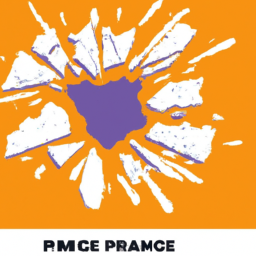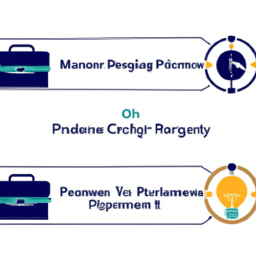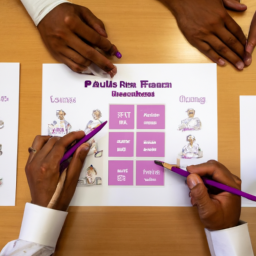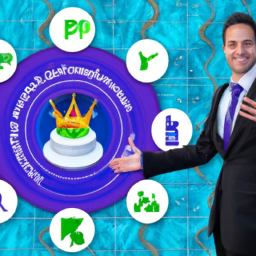Are you ready to conquer the PRINCE2 Practitioner Exam? Dive into the 7 key topics you must master to succeed.
From the PRINCE2 Methodology to Risk Management, this article will equip you with the knowledge and skills needed to excel.
Learn about Business Case, Organization and Roles, Planning and Control, Quality Management, and Change Management.
With this organized and detail-oriented guide, you’ll be well-prepared to tackle the exam and take your career to new heights.
Key Takeaways
- PRINCE2 methodology provides a structured approach to managing projects, ensuring they are delivered on time, within budget, and to required quality standards.
- The business case justifies the need for a project, assesses feasibility, benefits, costs, and risks, and guides resource allocation and risk mitigation.
- Well-defined team structure with clear roles and responsibilities, effective stakeholder management, and efficient resource allocation are important for successful project execution.
- Quality management involves planning, assurance, and control to ensure project deliverables meet quality standards, mitigate risks, and enhance customer satisfaction.
PRINCE2 Methodology
The PRINCE2 methodology is widely used in project management. It provides a structured approach to managing projects, ensuring that they are delivered on time, within budget, and to the required quality standards.
One of the key aspects of the PRINCE2 methodology is project governance. This refers to the framework of rules and processes that guide and control the project. It ensures that the project is aligned with the organization’s objectives and that decisions are made by the right people at the right time. Project governance includes defining roles and responsibilities, establishing clear communication channels, and implementing effective risk management practices.
Understanding project governance is crucial for successful project management using the PRINCE2 methodology.
Now let’s move on to the next topic, the importance of the business case in PRINCE2.
Business Case
Understand why a business case is crucial in project management and how it can help you make informed decisions. A business case is a document that justifies the need for a project by assessing its feasibility, benefits, costs, and risks. It provides a solid foundation for project initiation and acts as a reference point throughout the project lifecycle. Business case development involves conducting a cost benefit analysis to evaluate the potential return on investment and determine if the project aligns with the organization’s objectives. By developing a robust business case, you can ensure that resources are allocated effectively, risks are identified and mitigated, and stakeholders are engaged. It also helps you make informed decisions based on clear evidence and supports effective project governance. Consider the following table highlighting the key components of a business case:
| Component | Description | Emotional Response |
|---|---|---|
| Objectives | Clear and measurable project objectives | Clarity and focus on the desired outcome |
| Benefits | Expected benefits and their value | Excitement about the potential impact |
| Costs | Estimated costs and financial implications | Financial security and feasibility |
| Risks | Identified risks and their likelihood | Confidence in risk management |
| Alternatives | Assessment of alternative options | Confidence in the chosen solution |
Organization and Roles
In project management, incorporating a business case enhances decision-making and ensures efficient resource allocation.
When it comes to organization and roles, having a well-defined team structure is crucial. This involves clearly defining the roles and responsibilities of each team member, ensuring that everyone knows their specific tasks and objectives.
Effective stakeholder management is also essential, as it involves identifying and engaging with key stakeholders who have a vested interest in the project’s success. This helps to ensure their needs and expectations are understood and addressed throughout the project lifecycle.
Planning and Control
In this section, you’ll explore the critical aspects of planning and control in project management.
You’ll delve into key topics such as project scope management, resource allocation strategies, and risk identification techniques.
By understanding these concepts, you’ll be equipped with the knowledge and tools necessary to effectively plan and control your projects.
This will ensure their success and minimize potential risks.
Project Scope Management
The project team’s ability to define and control the project’s scope is crucial for successful Project Scope Management. Effective project scope definition ensures that all stakeholders have a clear understanding of what is included and excluded from the project. This helps in setting realistic expectations and avoiding misunderstandings. Scope creep prevention is another important aspect of project scope management. Scope creep refers to the uncontrolled expansion of project scope, leading to budget overruns, missed deadlines, and decreased customer satisfaction. To prevent scope creep, the project team should establish a change control process and closely monitor any changes requested by stakeholders. This ensures that all changes are evaluated for their impact on project scope, schedule, and budget before being approved. By managing project scope effectively, the project team can increase the likelihood of delivering a successful project.
| Project Scope Definition | Scope Creep Prevention |
|---|---|
| Clear understanding of what is included and excluded from the project | Establish a change control process |
| Setting realistic expectations | Monitor changes requested by stakeholders |
| Avoiding misunderstandings | Evaluate changes for their impact on project scope, schedule, and budget |
| Increased likelihood of delivering a successful project | Prevent budget overruns, missed deadlines, and decreased customer satisfaction |
Resource Allocation Strategies
One effective way to manage resource allocation is by using a matrix structure. This allows for resource optimization and efficient talent allocation.
Here are four key strategies to consider:
-
Functional Structure: Resources are grouped according to their specialized skills and expertise. This structure ensures that individuals are assigned to projects that align with their strengths, resulting in optimal resource utilization.
-
Project Structure: Resources are allocated based on project requirements. A dedicated project team is formed, enabling better coordination and collaboration among team members.
-
Matrix Structure: Combining the functional and project structures, this approach allows resources to be shared across multiple projects. This maximizes talent utilization while maintaining a focus on project-specific requirements.
-
Resource Pooling: Resources are pooled together and assigned to projects as needed. This flexible approach allows for efficient allocation of resources based on project priorities and timelines.
Risk Identification Techniques
To effectively identify risks, consider using techniques such as brainstorming and SWOT analysis. These risk identification methods are essential for any project to ensure that potential risks are recognized and addressed promptly.
Brainstorming involves gathering a group of stakeholders to generate ideas and identify potential risks based on their expertise and experience. This technique encourages open discussion and allows for the exploration of various perspectives.
On the other hand, SWOT analysis involves evaluating the project’s strengths, weaknesses, opportunities, and threats. By analyzing these factors, project managers can gain a comprehensive understanding of the project’s potential risks.
Once risks are identified, it is crucial to develop appropriate risk response strategies. These strategies may include avoiding, mitigating, transferring, or accepting risks.
Risk Management
In the realm of risk management, it’s crucial to identify potential risks and their potential impact on your project. By taking a proactive approach, you can effectively mitigate the impact of these risks on your project’s success.
This involves implementing strategies and actions to minimize the likelihood and severity of risks occurring, ensuring a smooth and successful project execution.
Identifying Potential Risks
When identifying potential risks in the Prince2 practitioner exam, you should use a systematic approach to assess and evaluate potential threats. This will help you to effectively manage and mitigate risks throughout the exam process.
Here are some key points to consider:
- Conduct a thorough risk assessment by identifying all possible risks that may arise during the exam.
- Evaluate the likelihood and impact of each identified risk to prioritize your focus and resources.
- Develop risk mitigation strategies to minimize the likelihood or impact of these risks.
- Regularly review and update your risk assessment and mitigation strategies to ensure their effectiveness.
Mitigating Risk Impact
By regularly updating and implementing effective risk mitigation strategies, you’ll be able to minimize the impact of potential risks in the Prince2 practitioner exam.
Risk assessment is a crucial step in identifying potential risks, but it is only the first part of the process. Once risks are identified, it is important to develop strategies to mitigate their impact.
There are several risk mitigation strategies that can be employed in the exam preparation phase. One strategy is to prioritize risks based on their likelihood and potential impact. This allows you to focus on the most critical risks first.
Another strategy is to develop contingency plans for each identified risk. These plans outline the actions to be taken if the risk materializes.
Regularly reviewing and updating these strategies will ensure that you are well-prepared to handle any potential risks that may arise during the Prince2 practitioner exam.
Quality Management
To excel in the Prince2 Practitioner exam, it is crucial to understand how quality management plays a vital role in project success.
Quality assurance is a key component of quality management. It ensures that project deliverables meet the required standards and specifications. This involves setting quality objectives, conducting audits, and implementing corrective actions.
Continuous improvement is another important aspect of quality management. It focuses on identifying areas for improvement and implementing changes to enhance project outcomes.
To effectively manage quality, it is necessary to understand the principles and processes of quality management. This includes quality planning, quality control, and quality review techniques.
Throughout the project lifecycle, it is essential to prioritize quality to achieve successful project outcomes.
-
Quality assurance
-
Continuous improvement
-
Quality planning
-
Quality control and review techniques
Change Management
Change management is an essential aspect of project success. It involves effectively managing and implementing changes to enhance outcomes.
When it comes to change management, there are various challenges that project managers must address. One common challenge is resistance to change from team members. People are often resistant to change because it disrupts their comfort zones and requires them to adapt to new ways of doing things.
Another challenge is communication. Effective communication is crucial to ensure that everyone is on board with the changes and understands why they are necessary.
To overcome these challenges, project managers can employ various change management techniques. These techniques include creating a clear and compelling vision for the change, involving stakeholders in the decision-making process, providing training and support to help employees adapt, and monitoring and evaluating the progress of the change.
Frequently Asked Questions
What Are the Main Principles of the PRINCE2 Methodology?
The main principles of the PRINCE2 methodology are essential to understand. They outline the framework for effective project management.
One of the key principles is the importance of a business case. This ensures that projects are aligned with the organization’s objectives and provide a clear justification for their initiation and continuation.
How Does the PRINCE2 Methodology Differ From Other Project Management Methodologies?
When comparing PRINCE2 methodology to other project management methodologies, you’ll find that it stands head and shoulders above the rest. Its structured approach and emphasis on continuous monitoring and control make it a standout choice.
One of its key advantages is its ability to adapt to any project size or complexity. By following its proven principles, you’ll have the tools to ensure successful project delivery every time.
What Is the Importance of a Business Case in PRINCE2 and How Is It Developed?
The importance of a business case in PRINCE2 cannot be overstated. It serves as a crucial document that outlines the justification for a project, including its objectives, costs, benefits, and risks.
Developing a business case involves gathering relevant information, conducting a thorough analysis, and presenting a compelling argument for the project’s viability. It requires careful consideration of various factors and stakeholder input.
A well-developed business case sets the foundation for successful project initiation and ensures alignment with organizational goals.
What Are the Key Roles and Responsibilities Within a PRINCE2 Project Organization?
Key roles and responsibilities within a PRINCE2 project organization are crucial for successful project management. As a practitioner, you must understand these key roles and their associated responsibilities.
The project board is responsible for overall project direction, while the project manager handles day-to-day management.
The team manager leads the team in delivering project products.
Other important roles include the project assurance, change authority, and project support.
Understanding these roles and responsibilities is vital for effective project execution.
How Does PRINCE2 Approach Risk Management and What Techniques Are Used to Identify and Manage Risks?
When it comes to risk management, PRINCE2 takes a structured approach. It emphasizes the importance of identifying and managing risks throughout the project.
Various techniques are used to identify risks, such as brainstorming, checklists, and expert judgment. Once risks are identified, they are assessed and prioritized based on their potential impact and likelihood.
PRINCE2 also focuses on developing effective risk responses and creating contingency plans to mitigate any potential issues that may arise.
Conclusion
Now that you’ve delved into the 7 key topics covered in the PRINCE2 Practitioner exam, you’ve gained a profound understanding of this renowned methodology.
Remember, mastering these topics is crucial for success in your professional endeavors.
By embracing the principles of PRINCE2, you’ll be equipped with the skills needed to navigate complex business cases, effectively manage risks, and implement change with finesse.
So, go forth with confidence and let the power of PRINCE2 guide you towards triumph in your project management journey.


















